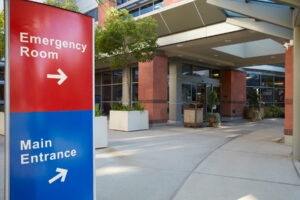
blog /
Choosing Between an ER Visit and Urgent Care After a Car Accident: Pros and Cons
Getting involved in a car accident can be a traumatic experience, and the priority should always be safety. After a car crash — time is of the essence.
While some injuries may be evident, others might not manifest symptoms until later. Seeking immediate medical attention is key to identifying and addressing these issues early on.
Knowing where to seek medical attention is crucial. In this blog, we’ll break down the pros and cons of an Emergency Room (ER) visit versus an Urgent Care visit.
What’s the difference between the ER and Urgent Care?
First let’s talk about how they’re both alike. Urgent cares and emergency rooms both serve as healthcare facilities with medical professionals treating people for various ailments. Where they differ is in the level of care and services provided.
Urgent care centers are adept at treating common issues like cold symptoms, fractures, sprains, and minor lacerations, offering shorter wait times and reduced costs.
On the other hand, the ER is tailored for extreme medical situations such as brain injuries, deep burns, and cardiac distress, providing a higher level of care, comprehensive resources, including imaging tests and access to specialists on call.
Let’s explore these differences a little further.

Emergency Room Pros and Cons
Getting immediate medical attention for life-threatening injuries is the biggest advantage of the emergency room visit. However, it comes with its own set of advantages and drawbacks.
Pros
- Comprehensive Care: Equipped to handle severe and life-threatening injuries such as severe burns, internal bleeding, or head trauma.
- Immediate Attention: Prioritizes emergencies, ensuring prompt medical attention and intervention.
- Insurance Coverage: Typically covered by health insurance plans for emergencies depending on your insurance provider.
- Advanced Radiology & Lab Services: Get lab work, x-rays, CT Scans, MRIs and Ultrasounds to help diagnose and treat auto injuries.
- Specialized Staff: The ER is equipped with specialized medical professionals and resources to handle emergency situations, providing immediate attention and comprehensive care.
- Immediate action can make a significant difference in critical situations.
Cons
- Longer Wait Times: Especially for minor injuries.
- Higher Costs: ER visits tend to be more expensive, particularly for non-emergency situations.
- Limited Capacity: You may experience delays during peak hours.
What are potentially life-threatening emergencies?
In a life-threatening emergency, every second counts. Life-threatening medical emergencies are severe situations that can be quite scary, especially after a motor vehicle accident.
If you or someone involved in the car accident experiences any of the following conditions or types of injuries, getting emergency room care can be potentially life-saving:
- Uncontrolled bleeding that doesn’t stop.
- Any sudden or severe breathing problems.
- Fainting, dizziness, weakness, change in vision or loss of consciousness.
- Sudden change in behavior, confusion, or difficulty speaking.
- Coughing up or vomiting blood.
- Chest pain or pressure that lasts more than a few minutes.
- Injuries to the head or spine that could be serious.
- Serious injuries such as broken bones, severe burns, or a deep large wound.
- Symptoms of whiplash such as: neck pain, neck stiffness, headaches, ringing in the ears.

Urgent Care Pros and Cons
While Urgent Care centers offer a more cost-effective and efficient medical care alternative for car accident victims with minor injuries, it’s essential to weigh the pros and cons before making a decision.
Pros
- Faster Access: Shorter wait times for non-severe injuries.
- Cost-Effective: Costs are typically much lower compared to the ER. On average, an urgent care visit may range from $800 to $1500.
- Convenience: Some urgent care facilities are open for extended hours, including evenings and weekends.
- Some Radiology: Some urgent cares have the capacity for x-rays and ultrasound to diagnose minor injuries and conditions.
Cons
- Limited Capacity: Typically do not have specialized equipment for critical situations. You may also experience delays during peak times.
- Insurance Considerations: Coverage may vary, and some plans may have restrictions depending on the insurance claim.
- Non-Emergency Focus: Urgent care clinics are not suitable for life-threatening emergencies.
- No Specialists: Should a condition be more severe than perceived, urgent cares are not equipped to get on-hand consultation from specialists. In this case, they will usually recommend you go to the ER for care.
What are considered minor injuries?
Urgent Care is an excellent option for individuals seeking medical attention for minor injuries, such as minor lacerations, sprains, or minor fractures.
If you or someone involved in the car accident experiences any of the following conditions or types of injuries, getting medical care at an urgent care could help:
- Muscle sprains/strains
- Minor fractures
- Small cuts
- Bruises
It’s important to note that many car accident injuries don’t show up until a day or days after the accident. As long as the injuries or symptoms are not life-threatening as we listed out above, it’s reasonable to seek medical attention at an urgent care. Many people will also seek alternative medical treatments from a chiropractor or physical therapy. As car accident lawyers, we can help you understand your personal injury claim, insurance coverage, medical expenses and get you compensation.
Let RHHK Car Accident Attorneys Support You on the Road to Recovery
Choosing between an ER visit and Urgent Care depends on the severity of the injuries. If you’ve been injured in a car accident, our experienced team is here to help. Contact us for a free consultation to discuss your situation. We can provide legal guidance, ensuring you receive the necessary medical care and compensation. Your recovery matters to us—let us help!